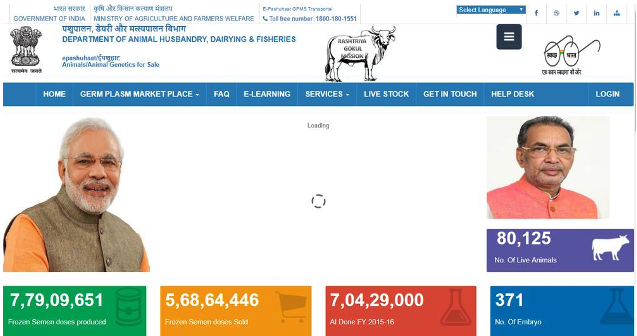🏃🏻♀️ Policy Measures
Recent Policy Measures and Institutes related to Animal Husbandry
Which of the following statement is correct?
Rashtriya Gokul Mission (RGM)
- Launched in
2014. - For conservation and development of indigenous breeds in a focused and scientific manner
- Aim is to protect cow breeds and increase the number of local cow breeds.
- Ministry of Agriculture, Department of Animal Husbandry, Dairying & Fisheries.
- To be implemented on 100% grant-in-aid basis.
Objectives
- Development and conservation of indigenous breeds
- Undertake breed improvement program
- Enhance milk production and productivity
- Upgrade nondescript cattle using elite indigenous breeds
- Distribute disease free high genetic merit bulls for natural service
National Livestock Mission
- The focus of the scheme is on entrepreneurship development and breed improvement in poultry, sheep, goat and piggery including feed and fodder development.
- The scheme is implemented with the following three Sub-Missions:
- Sub-Mission on Breed Development of Livestock & Poultry
- Sub-Mission on Feed and Fodder development
- Sub-Mission on Extension and Innovation
Sub-Mission on Breed Development of Livestock & Poultry
The sub-mission proposes to bring sharp focus on entrepreneurship development and breed improvement in poultry, sheep, goat and piggery by providing the incentivization to the individual, FPOs, SHGs, Section 8 companies for entrepreneurship development and also to the State Government for breed improvement infrastructure.
Sub-Mission on Feed and Fodder development
This sub-mission aims towards strengthening of fodder seed chain to improve availability of certified fodder seed required for fodder production and encouraging entrepreneurs for establishment of fodder Block/Hey Bailing/Silage Making Units through incentivisation.
Sub-Mission on Research & Development, Livestock Insurance, Extension and Innovation
The sub-mission aims to incentivize the Institutes, Universities, Organizations caring out research and development related to sheep, goat, pig and feed and fodder sector, extension activities, livestock insurance and innovation.
Livestock Health and Disease Control
- The overall aim of the Livestock Health & Disease Control scheme is to improve the animal health sector by way of implementation of prophylactic vaccination programmes against various diseases of livestock and poultry, capacity building, disease surveillance and strengthening of veterinary infrastructure.
- It is envisaged that implementation of the scheme will ultimately lead to prevention & control, subsequently eradicating the diseases, increased access to veterinary services, higher productivity from animals, boosting up of trade in livestock and poultry, in livestock and poultry products and improving socio-economic status of livestock and poultry farmers.
Objectives
- To implement Critical Animal disease control programme to eradicate Peste des Petits (PPR) by 2030 by vaccinating all sheep and goats and to control Classical Swine Fever (CSF) by vaccinating the entire pig population
- To provide veterinary services at the farmers’ doorstep through Mobile Veterinary Units (MVUs).
- To provide Assistance to States for Control of Animal Diseases (ASCAD) by prevention & control of important livestock and poultry diseases prevalent in different States / UTs as per the State /UT’s priorities.
National Programme for Dairy Development (NPDD)
- The NPDD scheme aims to enhance quality of milk and milk products and increase share of organized milk procurement. The scheme has two components: Under NPDD, Fund sharing Pattern of Centre & State is as under:
- Component ‘A’ focuses towards creating/strengthening of infrastructure for quality milk testing equipment as well as primary chilling facilities for State Cooperative Dairy Federations/ District Cooperative Milk Producers’ Union/SHG run private dairy/Milk Producer Companies/Farmer Producer Organisations. The scheme will be implemented across the country for the period of five year from 2021-22 to 2025-26.
- Component ‘B’ (Dairying Through Cooperatives) provides financial assistance from Japan International Cooperation Agency (JICA) as per project agreement already signed with them. It is an externally aided project, envisaged to be implemented during the period from 2021-22 to 2025-26 on pilot basis in Uttar Pradesh and Bihar initially with the objective of creation of necessary dairy infrastructure for the purpose of providing market linkages for the produce in villages and for strengthening of capacity building of stake-holding institutions from village to State level.
Animal Husbandry Statistics (AHS)
- The Animal Husbandry Statistics (AHS) Division of Department of Animal Husbandry & Dairying (DAHD) is entrusted with the generation of Animal Husbandry Statistics through the Centrally Sponsored Scheme “Livestock Census and Integrated Sample Survey” under the development programmes category with two components, (i) Livestock Census (LC) & (ii) Integrated Sample Survey (ISS).
- The scheme is being implemented by the Department of Animal Husbandry and Dairying through State Animal Husbandry Departments.
Division’s Mandate:
- Conducting quinquennial Livestock Census (LC).
- Conducting annual sample survey namely Integrated Sample Survey (ISS).
- Publishing All India Livestock Report consisting of livestock population of major species at National and States/UT level by use, sex and age.
- Publishing Breed-wise report based on the latest Livestock Census consisting of detail breed-wise livestock population at aggregate as well as segregated level.
- Publishing of annual publication title Basic Animal Husbandry Statistics to release the production estimates of four major livestock products like milk, meat, egg and wool.
National Animal Disease Control Programme (NADCP)
- National Animal Disease Control Programme (NADCP) is a flagship scheme launched by Hon’ble Prime Minister in September,
2019for control ofFoot & Mouth Disease (FMD)andBrucellosisby vaccinating 100% cattle, buffalo, sheep, goat and pig population for FMD and 100% bovine female calves of 4-8 months of age for brucellosis. - 100 % central funding with an outlay of Rs.13,343 crore for 5 years (2019-20 to 2023-24).
- The overall aim of the National Animal Disease Control Programme for FMD and Brucellosis (NADCP) is to control FMD by 2025 with vaccination and its eventual eradication by
2030. - To vaccinate over 500 Million Livestock including cattle, buffalo, sheep, goats and pigs against FMD.
- To vaccinate 36 Million Female Bovine Calves annually against Brucellosis disease.
- Trade embargo in the international market.
Dairy processing & Infrastructure Development Fund (DIDF)
- Consequent to the Union Budget 2017-18 announcement, Dairy Processing & Infrastructure Development Fund has been set up with a corpus of Rs. 8,004 crore with National Bank for Agriculture and Rural Development (NABARD).
- The CCEA in its meeting dated 12.09.2017 has approved the scheme which has the objective to provide subsidized loan @6.5% to capital stressed milk cooperatives for primarily replacing their decades old chilling and processing plants and addition of value added product plants.
- The Scheme envisages providing loan assistance to State Dairy Federations, District Milk Unions, Milk Producers Companies, Multi State Cooperatives and NDDB subsidiaries across the country who are termed as Eligible End Borrowers (EEBs).
Animal Husbandry Infrastructure Development Fund (AHIDF)
- Hon’ble Prime Minister has announced for setting up of
Rs. 15000 croreAnimal Husbandry Infrastructure Development Fund (AHIDF) under Atma Nirbhar Bharat Abhiyan stimulus package. - The Animal Husbandry Infrastructure Development (AHIDF) has been approved for incentivizing investments by individual entrepreneurs, private companies, MSME, Farmers Producers Organizations (FPOs) and Section 8 companies to establish:
- The dairy processing and value addition infrastructure
- Meat processing and value addition infrastructure
- Animal Feed Plant
Supporting Dairy Cooperatives & Farmer Producer Organizations (SDCFPO)
- A Scheme named “Supporting Dairy Cooperatives and Farmer Producer Organizations engaged in dairy activities” was approved to provide working capital loan to State Cooperatives and Federations.
- An amount of Rs. 303 crore has been released to National Dairy Development Board till December 2021 for implementation of the scheme.
Objectives
- To assist the State Dairy Cooperative Federations by providing soft working capital loan to tide over the crisis on account severely adverse market conditions or natural calamities.
- To provide stable market access to the dairy farmers.
- To enable State Cooperative Dairy Federations to continue to make timely payments of dues to the farmers.
- To enable the cooperatives to procure milk at a remunerative price from the farmers, even during the flush season.
E-Pashu Haat Portal

- An e-market portal for
bovine germplasmfor connecting breeders and farmers. - Government has launched e-Pashu Haat portal (www.epashuhaat.gov.in) for connecting breeders and farmers of
indigenous breeds. Through the portal farmers can obtain information on location of quality indigenous germplasm in the form live animals, semen doses and embryos. - This portal is playing crucial role in development and conservation of indigenous breeds.
KCC to Fishery and Animals Husbandry
- In terms of interest subvention scheme for KCC to fishery and animals’ husbandry, interest subvention of
2 %per annum provide short term loan up to 2 lakh.
Union Ministers
- Union Minister of Fisheries, Animal Husbandry and Dairying: Shri. Parshottam Rupala

References
- G.C. Banerjee: A Textbook of Animal Husbandry
- https://www.nddb.coop/
- https://drkurien.com/
- https://amul.com/
- Wikipedia
Which of the following statement is correct?
Rashtriya Gokul Mission (RGM)
- Launched in
2014. - For conservation and development of indigenous breeds in a focused and scientific manner
- Aim is to protect cow breeds and increase the number of local cow breeds.
- Ministry of Agriculture, Department of Animal Husbandry, Dairying & Fisheries.
- To be implemented on 100% grant-in-aid basis.
Objectives
- Development and conservation of indigenous breeds
- Undertake breed improvement program
- Enhance milk production and productivity
- Upgrade nondescript cattle using elite indigenous breeds
- Distribute disease free high genetic merit bulls for natural service
National Livestock Mission
- The focus of the scheme is on entrepreneurship development and breed improvement in poultry, sheep, goat and …
Become Successful With AgriDots
Learn the essential skills for getting a seat in the Exam with
🦄 You are a pro member!
Only use this page if purchasing a gift or enterprise account
Plan
- Unlimited access to PRO courses
- Quizzes with hand-picked meme prizes
- Invite to private Discord chat
- Free Sticker emailed
Lifetime
- All PRO-tier benefits
- Single payment, lifetime access
- 4,200 bonus xp points
- Next Level
T-shirt shipped worldwide

Yo! You just found a 20% discount using 👉 EASTEREGG

High-quality fitted cotton shirt produced by Next Level Apparel